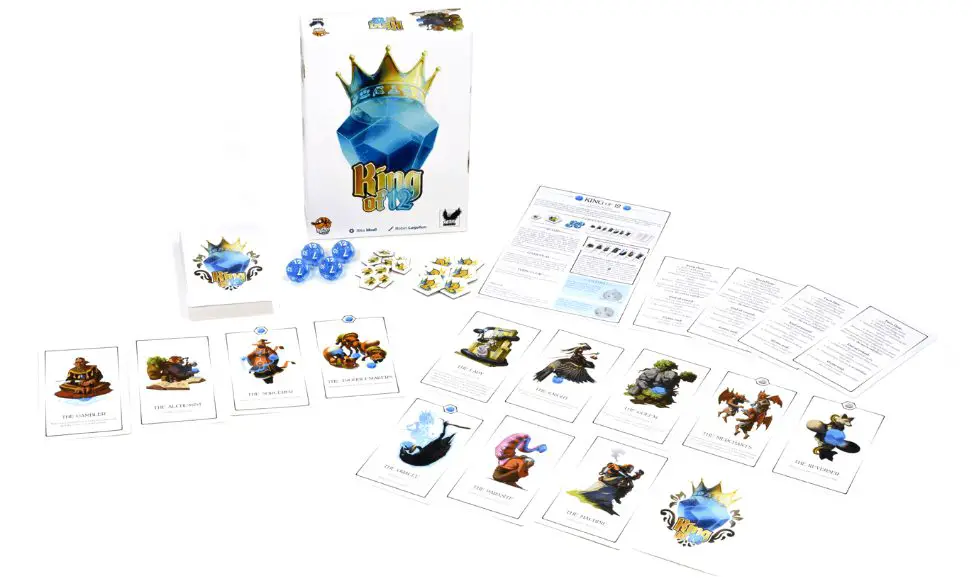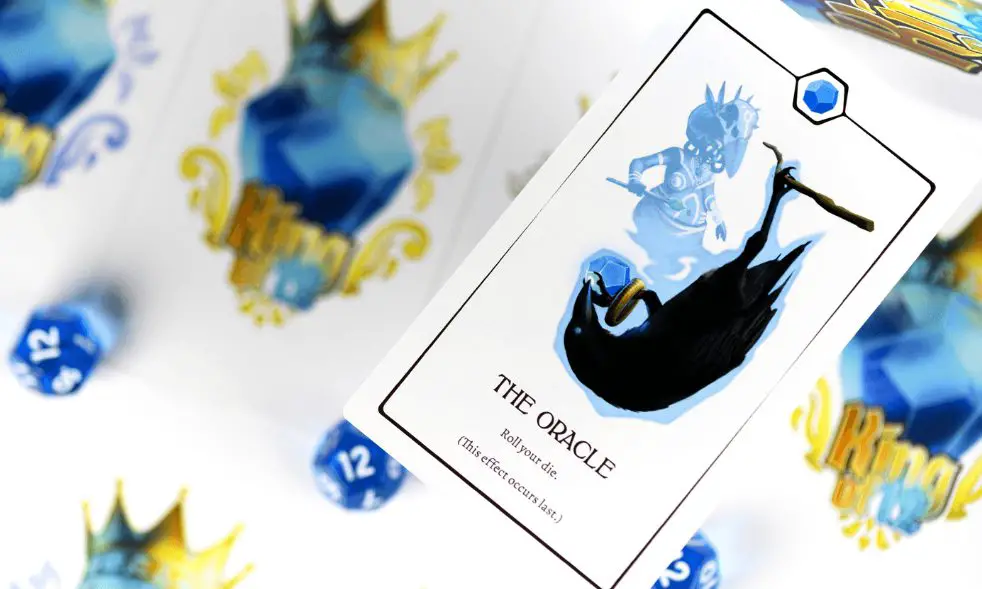King of 12 is a card game by Corax Games which was adapted for an English audience by Lucky Duck Games. Built for 2-4 players, it’s very easy to set up, learn, and play. It’s a fast paced game – a full game can be played in less than 20 minutes. The quality of that time, however short, is wonderfully high.
The twelve-sided stones of power decide who is to rule the twelve realms. The manipulation of the stones is an art, and impossible to accomplish alone. You‘ll need the support of beings from all across the Twelve Kingdoms. Only those who most skillfully employ their powers will claim the throne.
What’s In The Box?
- 4 Twelve-Sided Dice
- 15 Point Tokens
- 48 Character Cards (12 per person)
- 4 Reference Cards
- 1 Rule Sheet

How’s It Play?
King of 12 is played over several rounds, each with several turns. Players are given 7 cards and 1 twelve-sided die. All players roll their die, noting the number landed on. Unless indicated by a played card, the same dice roll will be used for the entire round. Each player secretly chooses a card, When all players have chosen, the cards are revealed simultaneously. If two of the played cards match, the cards cancel each other out and are discarded. Players activate the effect of their chosen card and compare the new values of their die. If two players have a matching die value, their dice are canceled out. The player with the highest value wins and gets a 2-point token. The runner up gets a 1-point token. The card played during the turn is discarded and the process repeats from the beginning.
The round ends when one player has 8 points or a player only has 1 card left, whichever occurs first. The person with the highest number of points wins. To start the next round, the winning player takes one card out of their 7 card deck and sets it to the side, leaving them with 6 playable cards. The game ends when a player has won two rounds.
The Verdict
King of 12 is a very straightforward game: roll the dice, play a card, win points. It was extremely easy to learn, with the instruction pamphlet giving examples along with each step. The game gives a suggested set of 7 cards to learn with/start with, but there are 12 potential cards that can be used in a deck. When playing, all card sets use The Knight card (“This turn, the lowest die value is the winner and the second lowest value is the runner-up”). This is a really helpful card if you’ve managed to roll a 2 on the die – and a dangerous card if you managed to hit the 12. It’s not a secret what die value the other players have, so certain cards can be played in a way to very specifically mess up an opponent. For example, when I played with my friends I used The Merchants (“Each player passes their die clockwise to the next player”) to target the person who had the most points, throwing them off their game.
Having a diverse set of playable cards keeps it from going stale and lets players get pretty creative the more they play. All the cards have the potential to be useful, but since all rounds will end with players having at least 1 card in their hand, if a card feels useless during the round it can be held onto without needing to be played. Having the disadvantage of taking a card away after winning a round means that the player has to think carefully about what their deck looks like.

Players can get very competitive while playing this game. Since matching cards cancel each other out, if it’s a two player game and the cards keep matching, the points are fully based on the roll at the beginning of the game – for better or for worse. Rolling poorly isn’t always a disadvantage because cards other than The Knight also can do spicy things. The card The Troublemakers (“All players rotate their die to the opposite side”) is really cool to have in a deck if you’ve rolled very low and someone else has rolled very high because the values reverse – a 1 becomes a 12, a 2 becomes an 11. However, if you’re the person who rolled very high, it’s easy to get very passionate about what you now have to work with. Customizing the deck from the suggested 7 adds to the levels of chaos that can be caused.
Even though there are very few moving parts for King of 12, each part is well constructed. The cards are large and easy to read with eye-catching art. The point tokens are made from stiff cardboard, keeping them from sliding around or bending when grabbed. The twelve-sided dice are an alluring shade of blue with very clear white numbers. The box it’s stored in isn’t very large so it’s the type of game that could be slipped in a backpack or an overnight bag.
King of 12 is an exciting game that’s fast to learn and fast to play. Having more players increases the fun, but it’s perfectly enjoyable as a game for a duo. King of 12 can be picked up from Lucky Duck Games for $24.99.
Images and review copy courtesy of Lucky Duck Games.
Have strong thoughts about this piece you need to share? Or maybe there’s something else on your mind you’re wanting to talk about with fellow Fandomentals? Head on over to our Community server to join in the conversation!

